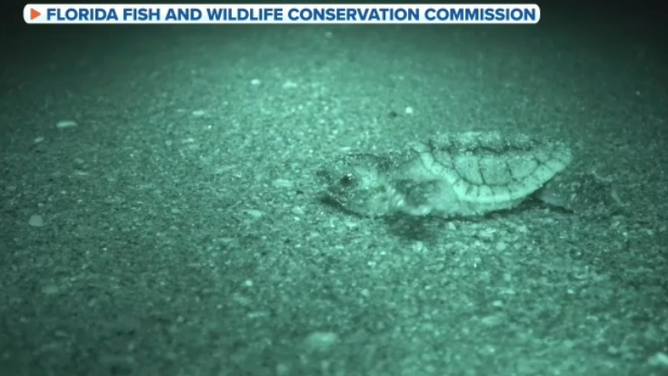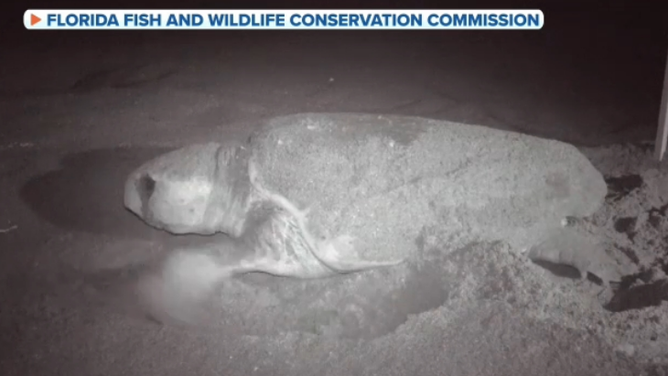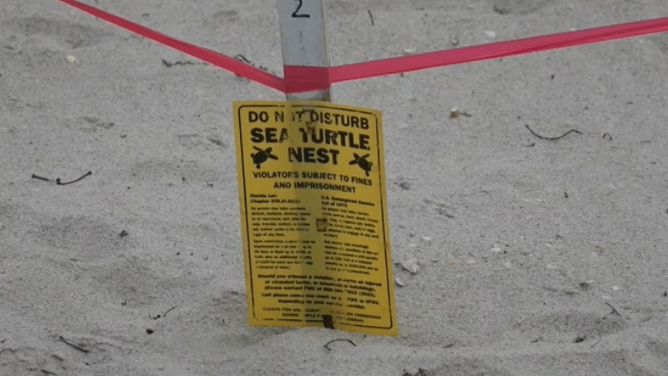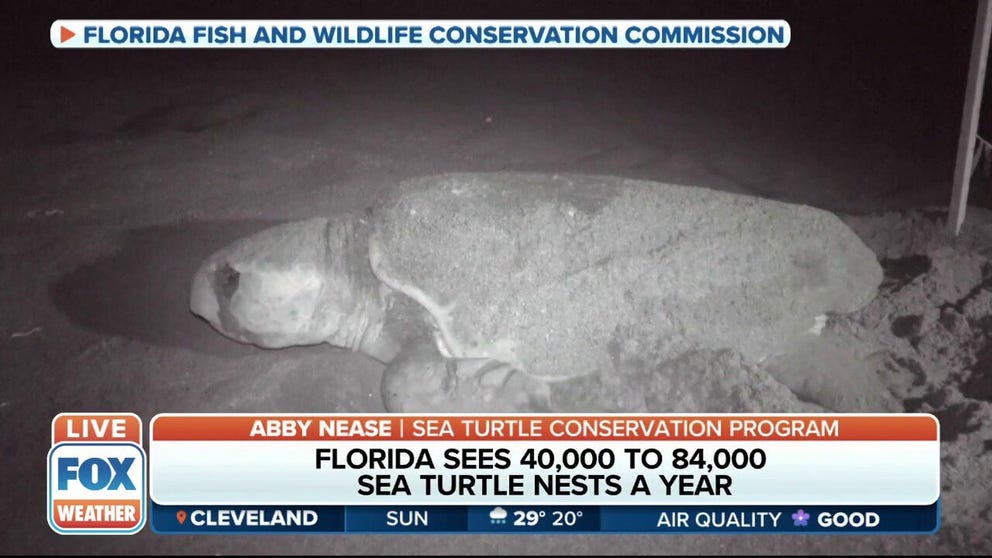Watch your step! Saving sea turtles during spring break
March signals the start of sea turtle nesting season which lasts through September.
Sea turtle nesting season underway on Florida beaches
FOX Weather multimedia journalist Brandy Campbell explains what’s being done to protect sea turtles on Florida beaches during nesting season.
Spring is in the air – flowers are blooming, spring breakers are breaking out the shorts and turtle nesting season is in full swing in the Southeast U.S. Some Florida residents feel like proud, protective parents over their annual "babies".
"I’ve watched them every single year, scurry right to the water," said beach resident John Starello. " It's a sight to see."

A sea turtle hatchling making a break for the surf.
(Florida Fish and Wildlife Conservation Commission)
The threatened loggerhead, leatherback and green sea turtles sometimes need a helping hand to ensure the success of their species, Starello and other neighbors told FOX Weather’s Brandy Campbell in Hollywood, Florida.
"It's a good feeling to know that you're doing something that's worthwhile and not just being somebody that's enjoying this beautiful environment we live in," said resident Joe Brown.
Watch where you step and keep down the light pollution
"Our development and our buildings are brighter than the ocean, and sometimes it confuses the turtles, and they crawl the wrong way," said Stephanie Roche, Broward County Environmental Project Coordinator.

A female sea turtle camouflages her nest after laying eggs.
(Florida Fish and Wildlife Conservation Commission)
Local laws ensure turtle-friendly lighting near the beach. Light pollution can discourage females from nesting and/or cause the hatchlings to run toward the building lights instead of the sea. Instinct tells sea turtles to run toward the brightest light on the horizon which is traditionally over the water.
The county requires all resorts, restaurants and homes on the beach to install low wattage (or lumen) lighting which gives off an amber or red color. Turtles are less sensitive to the warm light. The lights should also be shielded and mounted as low as possible to only illuminate tripping hazards on the ground, not widely broadcast.
Non-profit agencies and volunteers comb 24 miles of county beach every morning to identify new nests and put up barriers to protect the eggs from beach crowds.

Surveyors partition areas of the beach containing nests.
(FOX Weather)
"We just mark that off each morning," said Abby Nease, Project Manager of the Broward County Sea Turtle Conservation Program, as she surrounded a nest with plastic fencing. "And then we also maintain any of the nests that are on the beach to kind of protect them from any kind of human interaction."
Sea turtle nesting season underway on Florida beaches
FOX Weather multimedia journalist Brandy Campbell explains what’s being done to protect sea turtles on Florida beaches during nesting season.
An oceangoing female sea turtle swims back to the beach she was hatched every three years or so to breed. Beach goers can enjoy the spectacle across the Gulf and Atlantic Coasts from Texas to the Carolinas. Momma will dig a nest in the warm sand and lay between 80 and 120 eggs starting in late March.
GENDER REVEAL: SCIENTISTS SAY SAND DETERMINES THE SEX OF SEA TURTLES
A breeding female will lay about three to fives nests at night every two to three weeks. The turtle covers her eggs to protect them from predators then heads back to sea.

The hatchlings emerge about two months later and sprint for the shoreline. Nease said that only one in one thousand hatchlings make it to maturity. Septembers is generally considered the end of nesting season.
Nease’s team found 23 leatherback turtle nests so far this season and expect to find 2,000-3,000 before the end of nesting season. The group is part of two statewide monitoring programs through the Florida Fish and Wildlife Conservation Commission's Fish and Wildlife Research Institute.

A sea turtle hatchling emerging from its nest and ready to hit the water in search of a first meal.
(NOAA)
The Northwest Atlantic’s loggerhead nesting area in the Southeast U.S. is the largest in the word. About 90% of those nests are in Florida.
Nearly all leatherback turtles nest on Florida’s East Coast. And Palm Beach County hosts about 50% of the nests a year.
Much smaller numbers of the endangered Kemp’s ridley and hawksbill sea turtles nest in the Sunshine State as well.
SEAWORLD SUCCESSFULLY RETURNS 10 ENDANGERED SEA TURTLES BACK TO THE OCEAN
The E.P.A. defines endangered species as being so rare that they are in danger of being extinct. Threatened species, the E.P.A. said, are likely to become endanger in the foreseeable future.
